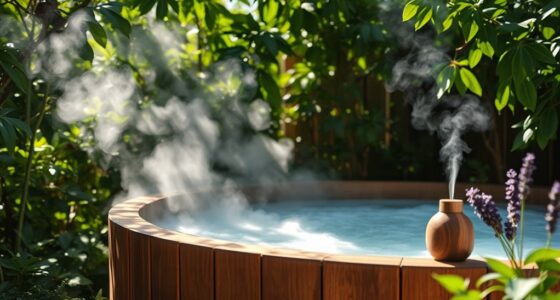Before trying cold plunges, assess your health carefully. If you have heart or respiratory issues, consult a healthcare professional first, since cold shock can increase heart rate and blood pressure. Start slowly, gradually increasing exposure time to build tolerance. Watch for signs of distress or overexposure. Understanding your body’s responses helps determine if cold water immersion benefits you. Keep exploring to discover detailed tips on safely integrating cold plunges into your routine.
Key Takeaways
- Consult your healthcare provider, especially if you have cardiovascular, respiratory, or chronic health conditions.
- Start with brief cold exposures and gradually increase duration to assess tolerance.
- Be aware of your body’s signals; discontinue cold plunges if you experience discomfort or adverse symptoms.
- Understand that cold shock responses can elevate heart rate and blood pressure, posing risks for some individuals.
- Evaluate personal health status and potential benefits to determine if cold immersion aligns with your wellness goals.

Have you ever wondered how a cold plunge could boost your health? Immersing yourself in icy water triggers a series of physiological responses that can be both invigorating and beneficial. One of the immediate effects is cold shock, a sudden, involuntary gasp and rapid breathing that occurs when you first enter cold water. While this reaction can be startling, it’s also part of your body’s way of initiating a series of adaptations. Over time, regular cold plunges may help strengthen your immune response, making you more resilient against infections. Cold exposure stimulates the production of white blood cells and increases circulation, which can help your body fight off illness more effectively. However, it’s essential to understand how these responses work and whether they’re suitable for your health status.
When you take a cold plunge, your body reacts by constricting blood vessels to conserve heat, which can initially cause discomfort but also promotes better blood flow once you’re out of the water. The cold shock response can elevate your heart rate and blood pressure temporarily, which might be concerning if you have underlying cardiovascular issues. For healthy individuals, these responses can act as a form of hormesis, where brief exposure to stressors like cold water encourages your body to adapt and become more resilient. This adaptation includes a boosted immune response, as cold exposure has been linked to increased production of immune cells, helping your body respond more effectively to pathogens.
That said, evaluating whether a cold plunge fits into your health routine requires careful consideration. If you have heart problems, respiratory issues, or other chronic conditions, the sudden cold shock could pose risks rather than benefits. It’s wise to consult your healthcare provider before starting cold water immersion, especially if you’re new to it or have existing health concerns. For others, gradually acclimating to colder temperatures and listening to your body’s signals is essential. Cold plunges are not a one-size-fits-all solution, and overdoing it can lead to hypothermia or increased stress on your cardiovascular system.
Frequently Asked Questions
Can Cold Plunges Replace Traditional Therapy Methods?
Cold plunges can’t replace traditional therapy methods, but they can complement your mental health and emotional well-being routines. While immersion in cold water may boost mood and reduce stress temporarily, it doesn’t address underlying issues like counseling or medication do. Use cold plunges as a supportive tool, not a substitute. Combining them with professional therapy can enhance your overall mental health and emotional resilience effectively.
How Long Should I Stay in a Cold Plunge Session?
You should aim for a cold plunge session lasting about 5 to 10 minutes, following safety precautions to prevent hypothermia. Start with shorter durations, around 2-3 minutes, and gradually increase as your body adapts. Listen to your body’s signals, and if you feel numbness, dizziness, or discomfort, exit immediately. Always prioritize safety precautions and consult a healthcare professional if you have underlying health conditions.
Are There Specific Times of Day Best for Cold Plunges?
Ever wonder when the stars align for a cold plunge? Ideal timing often depends on your goals, but many find morning benefits perfect for a revitalizing start. Taking a cold plunge in the morning can boost alertness and mood, setting a positive tone for the day. Plus, early dips may improve circulation and recovery. So, if you’re seeking energy and clarity, mornings could be your best bet.
What Are the Risks for Pregnant Women Using Cold Plunges?
Pregnant women should avoid cold plunges due to pregnancy safety concerns. Cold exposure risks include sudden drops in body temperature, which can affect blood flow and increase stress on your body. These changes may pose risks to your pregnancy, such as preterm labor or fetal distress. It’s best to consult your healthcare provider before considering cold exposure during pregnancy, ensuring both your safety and your baby’s health.
Can Cold Plunges Help Improve Athletic Recovery?
Imagine your muscles as a battlefield healing after a tough fight. Cold plunges act like a cooling breeze, speeding up muscle repair and reducing inflammation. They help flush out metabolic waste and ease soreness, making recovery smoother. If you’re an athlete, incorporating cold plunges can sharpen your edge, helping you bounce back faster and get ready for the next challenge with renewed strength.
Conclusion
Ultimately, whether a cold plunge is right for you depends on listening to your body and weighing the benefits against potential risks. It’s not just a trend but a tool that can boost your health if used wisely. Remember, the real power lies within your own choices—embrace what feels right, and let your instincts guide you. After all, you hold the key to revealing your best self, one cold splash at a time.









